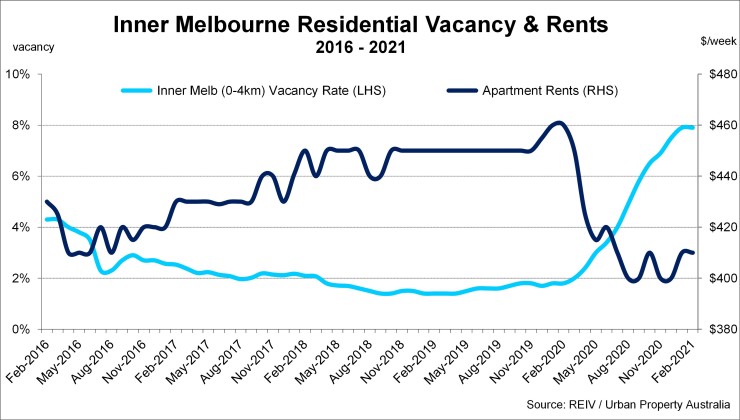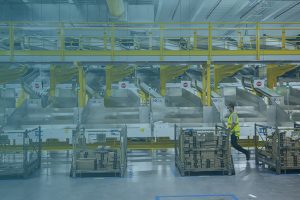Q1 2021 – Melbourne Apartment Market
April 12th 2021 | , Urban Property Australia
While there are 5,500 apartments forecast to be completed this year in the Inner-City precinct, in 2022 new supply is projected to fall to its lowest level in 10 years;
The vacancy rate for Inner-City precinct has increased to 15-year highs, rising to 7.9% from its 1.8% rate a year earlier;
Inner-City median apartment prices increased over the year, led by growth of 1-bedroom apartments.
Inner-City Melbourne Apartment Summary
With the Inner-City precinct estimated to have lost 79,000 jobs as a result of the pandemic along with the closure of Australia’s borders (restricting international students), the residential vacancy rate for Inner-City precinct has increased to 15-year highs. Despite the increase of vacancy, Inner-City apartment values have been maintained to date with median prices actually increasing into 2021.
Prices
While vacancy levels have increased and rental levels have decreased, values for Inner-City Melbourne apartments have increased slightly over the year. According to the REIV, median apartment prices increased to $629,500, up 2.7% over the year. Somewhat interestingly, over the past year, median prices of 1-bedroom apartments in the Inner-City precinct increased by 6.3% followed by median prices of 3-bedroom apartments which increased by 5.7%. While over the year, median prices of 2-bedroom apartments in the Inner-City precinct increased by 2.6% to $636,000. While Inner-City apartment values have remained stable for the past 18 months, Urban Property maintains there is a risk of price falls with subdued investor demand, the remaining uncertainty of the international

Supply
Currently there are 9,400 apartments under construction within the Inner-City Melbourne region. With 780 apartments already completed in 2021, Urban Property Australia research forecasts that 5,500 apartments will be completed this year. Of the 70 new developments currently under construction, 64% of the apartments are located in the CBD Core, followed by 18% in Southbank and 7% are located in Docklands. Looking ahead, while there are a further 35,000 apartments with plans approved in the Inner-City Melbourne region, Urban Property Australia’s research forecasts that the supply pipeline has peaked in the short term. Supply levels are projected to fall below the long-term average in 2022 for the first time since 2013.
Demand
With the Inner-City precinct estimated to lose 79,000 jobs as a result of the pandemic, 36,000 international students living or studying in the precinct and office occupancy levels still only at 35% as at March 2021, demand for Inner-City apartments has been modest since the emergence of COVID-19. Transactional volumes for apartments in the Inner-City Melbourne precinct totalled 800 in 2021 to date with only 3,034 transacted over the full year of 2020, its lowest level in eight years and 28% below 2019 levels and 67% below 2015 levels. Sales activity for Inner-City apartments are expected to remain subdued with investor demand to have softened with international migration likely to constrained until 2022. Having once accounted for 45% of all housing finance in early 2015, investor lending in Victoria now accounts for 24% of all loans.
Vacancy
According to the REIV, as at February 2021, the residential vacancy rate for the Inner-City precinct has increased to 15-year highs, with the 0-4km precinct increasing to 7.9% (up from 1.8% as at February 2020) while the residential vacancy rate for properties in the 4-10km radius of the GPO increased to 7.3%, up from 2.1% a year earlier. Looking ahead, Urban Property forecasts that the vacancy rates for the Inner Melbourne precinct has peaked as workers steadily return to the CBD, however vacancy rates are likely to remain above the long-term average for the next two years impacted by the lack of international students.
Rents
Inner Melbourne apartment rents fell to their lowest level in 10 years through 2020 having been adversely impacted by the lack of demand from international students and CBD workers. Having peaked at $460/week as at February 2020, Inner Melbourne apartment rents now average $410/week as at February 2021 according to the REIV. Urban Property Australia forecasts that although Inner Melbourne rents seem to have stabilised, demand would have to markedly lift to underpin rental growth and pre-COVID highs unlikely to be surpassed until 2023.

Copyright © 2021 by Urban Property Australia All rights reserved. No part of this publication may be reproduced in any form, by microfilm, xerography, electronically or otherwise, or incorporated into any information retrieval system, without the written permission of the copyright owner.



